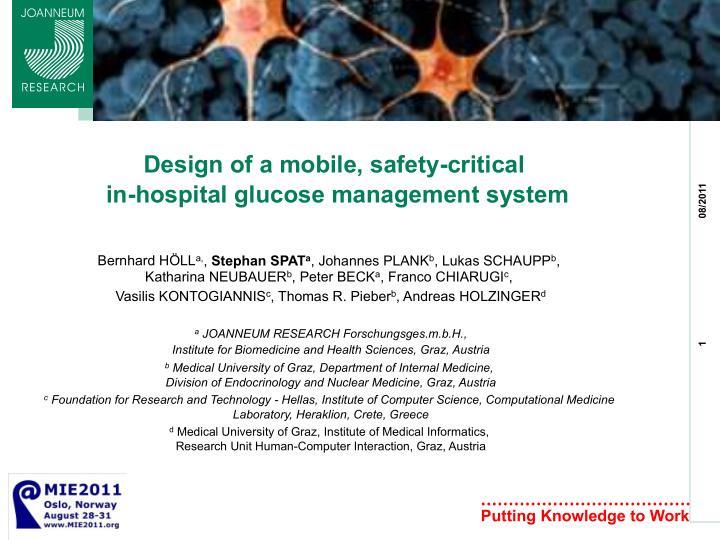



Design of a mobile, safety-critical in-hospital glucose management system 1 08/2011 Bernhard HÖLL a, , Stephan SPAT a , Johannes PLANK b , Lukas SCHAUPP b , Katharina NEUBAUER b , Peter BECK a , Franco CHIARUGI c , Vasilis KONTOGIANNIS c , Thomas R. Pieber b , Andreas HOLZINGER d a JOANNEUM RESEARCH Forschungsges.m.b.H., Institute for Biomedicine and Health Sciences, Graz, Austria b Medical University of Graz, Department of Internal Medicine, Division of Endocrinology and Nuclear Medicine, Graz, Austria c Foundation for Research and Technology - Hellas, Institute of Computer Science, Computational Medicine Laboratory, Heraklion, Crete, Greece d Medical University of Graz, Institute of Medical Informatics, Research Unit Human-Computer Interaction, Graz, Austria Putting Knowledge to Work
Motivation — in-patient glycemic control of acute diseased patients with diabetes is often considered secondary in importance 2 08/2011 — in-patient hyperglycaemia important marker of poor clinical outcome and mortality among diabetic patients — treatment of diabetes and hyperglycaemia results in reduced mortality and morbidity [1] à patients suffering from diabetes require continuous glycemic control during in-patient stays including close monitoring of blood glucose and determination of suitable treatment strategies [1] CLEMENT, S., BRAITHWAITE, S. S., MAGEE, M. F., AHMANN, A., SMITH, E. P., SCHAFER, R. G. & HIRSCH, I. B., (2004) Management of Diabetes and Hyperglycemia in Hospitals. Diabetes Care, 27, 2, 553-591. Putting Knowledge to Work
Current situation at ward ward physician 3 08/2011 Patient A n i g h Diabetes type 2 t s nurse h i f t Patient B No Diabetes specialist physician at ward round Putting Knowledge to Work
General requirements Execution of the application via a mobile device to perform activities — directly at the point of care (patients bed) 4 08/2011 No data storage on the mobile device . Wireless communication via web — services to an external server, on which the data should be placed Distributed/time-independend access to data from any place in the hospital — Documentation and visualization of the most important parameters relating — to diabetes care on the mobile device Automated decision support for insulin dosage [2],[3] — Reminder for open tasks through an active task management — Avoidance of manual (and multiple) inputs. A connection to the hospital and — laboratory information system is necessary in order to transfer administrative data automatically à integration of system [2] UMPIERRREZ, G. E., HOR, T., SMILEY, D., TEMPONI, A., UMPIEREZ, D., CERON, M., MUNOZ, C., NEWTON, C., PENG, L. & BALDWIN, D. (2009) Comparison of Inpatient Insulin Regimens with Detemir plus Aspart Versus Neutral Protamine Hagedorn plus Regular in Medical Patients with Type 2 Diabetes. Journal of Clinical Endocrinology Metabolism, 94, 2, 564-569. [3] UMPIERREZ, G. E., SMILEY, D., ZISMANN, A., PRIETO, L. M., PALACIO, A., CERON, M., PUIG, A. & MEJIA, R. (2007) Randomized Study of Basal-Bolus Insulin Therapy in the Inpatient Management of Patients with Type 2 Diabetes (RABBIT 2 Trial). Diabetes Care, 30, 9, 2181-2186. Putting Knowledge to Work
Methods interdisciplinary team (physicians, nurses, technicians, IT-Experts) — user-centred design approach — mock-ups and early prototypes as trigger for clinical personnel — 5 08/2011 iterative approach — continuous risk management — usability testing (Thinking Aloud) — Putting Knowledge to Work
Results Evolution of Solution – Excel prototype 6 08/2011 Putting Knowledge to Work
Results Evolution of Solution – 1 st usability study Evolution of Solution – Mock-up for mobile application 7 08/2011 Putting Knowledge to Work
Results Evolution of Solution – prototype implementation 8 08/2011 Putting Knowledge to Work
Results Evolution of Solution – prototype implementation 9 08/2011 Putting Knowledge to Work
Results Evolution of Solution – prototype implementation 10 08/2011 Putting Knowledge to Work
Conclusion Physicians and nurses have been involved in each design step — à end-users have determined main parts of functionality and design 11 08/2011 Use of triggers (mock-ups/prototypes) — à end-users got a better idea of design possibilities/functionality à base for decisions and compromises between users à base for further development and/or changes Clinicians/nurses and engineers have very different points of view concerning — software à Clinicians/nurses: only basic functionality; no manual input; easy but well sophisticated user interface, tailored to current workflow patterns; system integration à Technicians/IT-Experts: focus on gathering as much functionality as possible User-centred approach as important precondition to meet the requirements of — medical device directive for software (IEC 62366 standard) Putting Knowledge to Work
Outlook — on-going: clinical study of decision support for insulin dosage on paper at Medical University of Graz (MUG) 12 08/2011 — finishing of implementation work — Integration of security WSS, Entity Management — Interfaces to HIS/LIS — 2 nd usability study — clinical study with software solution at department of Endocrinology at MUG Putting Knowledge to Work
Thank you! 13 08/2011 Contact details è Stephan Spat / Bernhard Höll è JOANNEUM RESEARCH Forschungsgesellschaft mbH, Institute for Biomedicine and Health Sciences , Elisabethstraße 11a , 8010 Graz, Austria è Phone: +43 (0) 316 876 2157 è E-mail: stephan.spat@joanneum.at, bernhard.hoell@joanneum.at è Homepage: http://www.joanneum.at/ Acknowledgements. This work was partly funded by the E. C. under the 7 th Framework Program in the area of Personal Health Systems under Grant Agreement no. 248590. Homepage: http://www.reactionproject.eu/news.php Putting Knowledge to Work
Recommend
More recommend